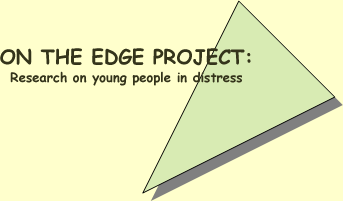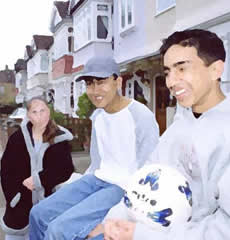Project Findings
We spoke to 69 young people, in focus groups and interviews. These young people were aged 16-25, and lived either in South Wales or the North of England. Our research report gives an overview of how young people think about suicide. It also examines the how issues around sexuality and gender identity may be connected to self-harm and suicide.
You can download the full project summary, (in PDF format), from here.
Or read online below:
ON THE EDGE:
RESEARCH ON YOUNG PEOPLE IN DISTRESS
RESEARCH REPORT
What we wanted to find out
We had two main questions to try and answer in this research:
- How do young people think about suicide and self-harm? (e.g. are young people sympathetic to these things or judgemental? do they think suicide or self-harm are possibilities for them or are they out of the question?)
- How are difficulties to do with sexuality (e.g. coming out as gay when people around you are homophobic) connected to self-harm and suicide?
We were interested in sexuality and gender because LGBT (lesbian, gay, bisexual and transgender) young people seem to be especially at risk of thinking about suicide and attempting it.
How we did the research
We spoke to 69 young people in total, in focus groups and interviews. These young people were aged 16-25, and lived either in South Wales or the North of England. They were a diverse group – LGBT and straight, white and ethnic minority, from cities and from small towns or villages, working class and middle class. We contacted young people through school, colleges, youth groups and so on.
What we found out
What is the general picture of how young people think about suicide?
- How do young people think about suicide and self-harm?
For SUICIDE, we identified four different themes in young people’s views. These don’t fit together neatly. There are some contradictions in how young people think about suicide. These are the four themes:
- Suicide and suicide attempts were seen as things that other people do, not us. Suicide is horrible and you might well not be sympathetic to people who do it.
- Suicide was seen as quite available to young people – some young people said that we all know people who’ve thought about it or done it and you only have to search google to find out about it.
- There was a view that people must have good reasons for suicide and they must weigh all this up when deciding to kill themselves.
- There was also a view that relationships are all-important and they can help to stop people killing themselves.
When talking about SELF-HARM the young people were generally referring to people cutting themselves. There was a clear divide set between two very different things people said about self-harm:
- When it is done in private and no-one knows about it, the young people we spoke to said that it shows real distress and we should be sympathetic.
- When people deliberately show their scars they may be seen as ‘attention-seeking.’ In this case, some of the people we spoke to thought that those who self-harm do not deserve the same kind of sympathy because they are being over-dramatic.
Part of the role of research is to report what kinds of things young people said. Research is also about asking questions and presenting new ideas and possibly challenges. There are some problems with the points of view we’ve described above. For example, if you think suicide is something that only other people do and that it is horrible, then how will you react to a friend who confides that they’re feeling suicidal? If you are very judgemental about people who let their self-harm scars be seen, then that might only make them feel even more isolated than they already do. These are the kinds of issues that have come out of this research project.
- How are difficulties to do with sexuality and gender identity connected to self-harm and suicide?
Although some of the straight young people we spoke to said they thought most people these days are pretty accepting of all kinds of sexuality, the LGBT young people we spoke to had lots of stories to tell about hostility and not being accepted by their families and by other young people they knew. There were several different ways that they dealt with these problems.
- Being strong despite the hostility (or even because of it)
- Having mixed feelings about how to deal with the hostility
- Self-destructive behaviour, including self-harm and suicide
We thought shame was an important emotion in connection with sexuality – that LGBT young people have to work hard to avoid feeling shame because their sexuality goes against the mainstream of society, and if they can’t avoid this shame they may be more likely to harm themselves. These are the ways in which we thought LGBT young people avoided shame:
- Expecting a certain level of homophobia and playing it down
- Being ‘adult’ about homophobia – some young people saw it as their role to take responsibility for teaching people to accept all kinds of sexuality.
- By saying they are ‘Out and Proud’
There are some difficult things about all of these. Playing down homophobia as ‘not so bad’ can allow it to carry on. The idea that LGBT people are responsible for teaching others about discrimination puts a lot of pressure on LGBT people themselves when they are not the problem! Also there can be a pressure to feel straightforwardly happy about being ‘Out’ and this might not allow for those who have some mixed feelings or are unsure of themselves.
We have made this research report very brief to fit it into 4 pages! If you’d like to read a much longer version, or get in touch with us, please see our website:
http://www.ontheedge.lancs.ac.uk/details.htm


